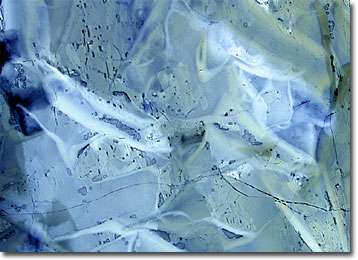Polarized Light Microscopy Digital Image Gallery
Nicotine
Nicotine is a poisonous liquid alkaloid that turns brown and gives off a pungent odor when exposed to light or air. Though found throughout the tobacco plant, the oily substance occurs in greatest concentration in the leaves where it helps discourage insect attacks.

Both nicotine and the genus name of the tobacco plant were named for a French ambassador to Portugal named Jean Nicot, who sent seeds of the plant to Paris in 1550. Nicot is further credited with experimenting with crushed tobacco leaves to cure headaches and introducing this snuff to the French court, where the habit of inhaling tobacco soon became highly fashionable. Nevertheless, many other parts of the world were already very familiar with the plantís effects, which typically consist of a feeling of well-being and increased alertness or relaxation. Native Americans and other peoples living in locales where tobacco plants were native had already been smoking, chewing, and inhaling the substance for hundreds of years.
Despite its seemingly benign effects in small doses, larger quantities of nicotine are highly toxic and may cause dizziness, headaches, vomiting, stomach pain, and, in extreme cases, convulsions and death. Nicotine may also have long-term adverse effects on oneís health and is physiologically addictive. The addictiveness of nicotine is the reason why most smokers who attempt to quit suffer withdrawal symptoms and, often, a relapse. Some products, such as Nicoderm, Nicorette, and ProStep, attempt to ease this transition through topical or systemic intake of nicotine. Yet, some research suggests that prolonged use of nicotine replacements may also cause health problems.
